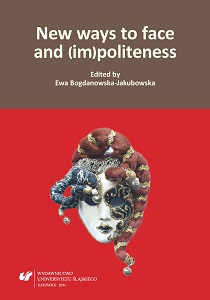Multiple contexts of face
Multiple contexts of face
Author(s): Ewa Bogdanowska-Jakubowska
Subject(s): Language studies, Language and Literature Studies, Theoretical Linguistics, Applied Linguistics, Sociolinguistics
Published by: Wydawnictwo Uniwersytetu Śląskiego
Keywords: multiple contexts; face
Summary/Abstract: Face is a sociocultural construct which is based on the person’s sense of identity and expectations as to how his/her self-image should be created, and constitutes a property of relationship between interactants (cf. Arundale, 2006; Bousfield, 2008; Spencer-Oatey & Franklin, 2009). As such it appears to be strongly context dependent. Context is understood here as “aspects of the social environment” which become “observable” by their consequences on discourse, or by the influence of discourse on social situations (van Dijk, 2006, p. 164). Contexts of social interactions in which face is constituted are “subjective participant interpretations” of the relevant aspects of the social environment.The aims of the study are to analyse the mechanisms responsible for face creation during social interaction and to investigate the role of context as a subjective face-constituting factor. Face has a structure which can be compared to lettuce; it gets softer towards its centre. Some aspects of face, the central (internal) ones, are most sensitive and vulnerable to attack or damage; others – the more distant from the centre (external) are less vulnerable to face-threats. It may be assumed that in the majority of cultures people display affective sensitivity to the same aspects of face, the only difference is in the degree of their importance and in their location relative to the centre of face. Irrespective of the degree of sensitivity specific to a particular aspect of face, we can observe different contexts in which particular aspects of face are foregrounded.
Book: New ways to face and (im)politeness
- Page Range: 31-50
- Page Count: 20
- Publication Year: 2016
- Language: English
- Content File-PDF

